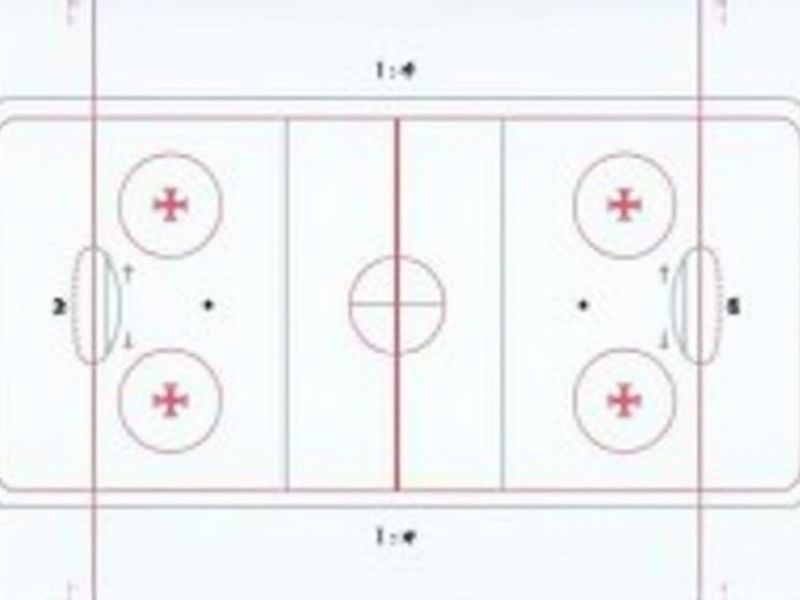
The standard dimensions of an ice hockey rink used in professional leagues such as the NHL are 200 feet long by 85 feet wide (approximately 61 meters by 26 meters). These measurements provide enough space for fast-paced play and allow for strategic movement by both teams. In contrast, international ice hockey rinks, like those used for the Olympics, are typically a bit larger at 197 feet by 98.4 feet (60 meters by 30 meters). Understanding these dimensions is helpful if you're planning to watch a game, set up a rink, or simply want to appreciate how the size affects play styles and strategies.
Total Length: 200 Feet
The standard dimensions of an ice hockey rink showcase a total length of 200 feet, crucial for gameplay. This measurement ensures ample space for competitive play, while the width typically measures 85 feet, creating a rectangular playing area of 17,000 square feet. The rink is divided into three zones: the offensive, defensive, and neutral zones, each with specific strategies and rules governing player movement and puck handling. For your ideal hockey experience, understanding these dimensions is key to appreciating the sport's dynamic nature.
Total Width: 85 Feet
The standard ice hockey rink has a total width of 85 feet, which is crucial for maintaining gameplay dynamics and player safety. This width allows for ample space for players to maneuver and execute plays effectively. The overall dimensions of a professional rink typically measure 200 feet long by 85 feet wide, ensuring a balanced playing field. When planning your ice hockey experience, it's important to consider these specifications for optimal performance and engagement.
Corner Radius: 28 Feet
The standard ice hockey rink features a corner radius of 28 feet, ensuring smooth transitions for players during fast-paced gameplay. This radius is integral to maintaining athlete safety and optimizing performance, as it facilitates sharper turns and minimizes the risk of collisions. In a full-size rink, measuring 200 feet in length and 85 feet in width, this design element plays a crucial role in gameplay dynamics. Your understanding of these specifications enhances appreciation for the strategic elements and physical demands unique to ice hockey.
Blue Line Width: 12 Inches
The ice hockey rink features a blue line that is precisely 12 inches wide, making it a critical element in gameplay. This blue line, located 60 feet from the goal line, aids in defining the offensive and defensive zones. Regulation rinks adhere to these dimensions to ensure consistency across all levels of play. Understanding the significance of the blue line can enhance your appreciation of strategic positioning and game flow.
Center Circle Diameter: 30 Feet
The standard ice hockey rink features a center circle with a diameter of 30 feet, crucial for face-off procedures. This circle is marked at the center of the rink, allowing players to strategically position themselves during gameplay. The dimensions contribute to maintaining the flow and pace of the game, emphasizing the importance of precise positioning. Understanding rink specifications, such as the center circle, can enhance your appreciation of ice hockey's strategy and complexity.
Goal Line Distance To Boards: 11 Feet
The standard ice hockey rink features a goal line positioned 11 feet from the boards, ensuring sufficient space for players while promoting strategic play. This distance allows for effective puck handling, shot opportunities, and defensive maneuvering near the goal area. Maintaining this measurement is crucial for adherence to international regulations, enhancing the safety and competitive integrity of the game. For optimal performance, players should utilize this space to create scoring chances and engage with opposing defenders effectively.
Neutral Zone Length: 50 Feet
The neutral zone of an ice hockey rink measures 50 feet in length, creating a critical area between the two blue lines that influences gameplay dynamics. This space serves as a transition zone for both teams to regroup and strategize, affecting offensive and defensive plays. Understanding the significance of the neutral zone can enhance your appreciation of team tactics and positioning during a match. The layout of the rink, with a total width of 200 feet and a length of 85 feet, further defines the importance of this key area for effective skating and puck movement.
Face-Off Spot Diameter: 2 Feet
The standard ice hockey rink features a face-off spot with a diameter of 2 feet, ensuring a consistent and regulated area for puck drops. This critical zone facilitates fair play and maintains the flow of the game, especially during face-offs. Positioned strategically throughout the rink, these face-off spots enhance gameplay dynamics, contributing to player strategy and engagement. Understanding these dimensions can improve your appreciation for the sport's intricate rules and structure.
Distance Between Blue Lines: 50 Feet
The standard distance between the blue lines on an ice hockey rink is 50 feet (15.24 meters). This measurement is crucial for defining various game zones, including the offensive and defensive zones. Each blue line plays a vital role in determining offside plays and facilitating strategic gameplay. Understanding these dimensions can enhance your appreciation of the game's structure and flow.
Thickness Of Ice: 1 To 1.5 Inches
The thickness of ice on a standard ice hockey rink typically ranges from 1 to 1.5 inches, providing optimal conditions for gameplay. Maintaining this thickness ensures a smooth and consistent surface, which is crucial for the speed and agility of the game. When the ice is properly prepared, players can execute precise maneuvers, leading to a more dynamic match. Regular maintenance is essential to uphold these standards, ensuring safety and enhancing your overall hockey experience.
